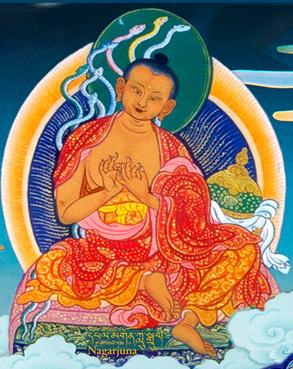Praise of the Dharmadhatu: Difference between revisions
No edit summary |
m (Sébastien moved page Praise to the Dharmadhatu to Praise of Dharmadhatu) |
(No difference)
| |
Revision as of 14:30, 18 December 2023

Praise of Dharmadhatu (Skt. Dharmadhātustava; Tib. ཆོས་ཀྱི་དབྱིངས་སུ་བསྟོད་པ་, Wyl. chos kyi dbyings su bstod pa) – a shastra written by Nagarjuna concerning the intention of the third turning of the Wheel of Dharma. It belongs to Nagarjuna’s Collection of Praises.
This text is primarily about buddha nature—called dharmadhatu in this context. Nagarjuna shows how buddha nature exists in all beings, is temporarily obscured, and can be revealed in its full bloom. The emphasis is on the actual experience of mind's vivid wakefulness.
Text
Only six verses (18–23) of this text are preserved in Sanskrit, as quoted in Naropa’s Sekoddeśaṭīkā.
Early Translations
The Tibetan translation in 101 verses was prepared by Krishna Paṇḍita and the Tibetan translator Nagtso Lotsawa Tsültrim Gyalwa during the middle of the eleventh century. It can be found in the Tengyur, Eulogy section, Toh 1118
The Chinese Buddhist canon contains two translations of the Dharmadhātustava (Taishō 413 and 1675), translated by the famous tantric master Amoghavajra (705–774) and Dānapāla from Uḍḍiyāna in the early eleventh century, respectively.
Modern Translations
- Karl Brunnholz, In Praise of Dharmadhatu, by Nagarjuna with commentary by the Third Karmapa, translated by Karl Brunnholz (Ithaca, New York: Snow Lion Publications, 2007)
Commentaries
- The Third Karmapa, Rangjung Dorje